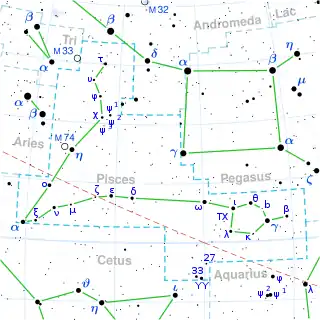 | |
| Observation data Epoch J2000 Equinox J2000 | |
|---|---|
| Constellation | Pisces |
| Right ascension | 23h 58m 40.37708s[1] |
| Declination | −03° 33′ 21.5379″[1] |
| Apparent magnitude (V) | 4.88[2] (4.90 + 8.90)[3] |
| Characteristics | |
| Spectral type | G8 III[4] |
| B−V color index | 0.930[2] |
| Astrometry | |
| Radial velocity (Rv) | −0.20±0.07[5] km/s |
| Proper motion (μ) | RA: −57.13[1] mas/yr Dec.: −72.08[1] mas/yr |
| Parallax (π) | 13.91 ± 0.28 mas[1] |
| Distance | 234 ± 5 ly (72 ± 1 pc) |
| Absolute magnitude (MV) | 0.60[2] |
| Orbit[6] | |
| Period (P) | 695 yr |
| Semi-major axis (a) | 3.67″ |
| Eccentricity (e) | 0.766 |
| Inclination (i) | 81.0° |
| Longitude of the node (Ω) | 81.1° |
| Periastron epoch (T) | 2550.00 |
| Argument of periastron (ω) (secondary) | 109.6° |
| Details[5] | |
| 55 Per A | |
| Mass | 2.39±0.12 M☉ |
| Radius | 9.73±0.51 R☉ |
| Luminosity | 56+11 −9 L☉ |
| Surface gravity (log g) | 2.82±0.07 cgs |
| Temperature | 5,014±23 K |
| Metallicity [Fe/H] | 0.03±0.05 dex |
| Rotational velocity (v sin i) | 1.29±0.56 km/s |
| Age | 710±120 Myr |
| Other designations | |
| Database references | |
| SIMBAD | data |
27 Piscium is a binary star system in the zodiac constellation of Pisces. It is visible to the naked eye with an apparent visual magnitude of 4.88.[2] Based upon an annual parallax shift of 13.91±0.28 mas,[1] it is located about 234 light years away. The system is positioned near the ecliptic and so is subject to occultation by the Moon.[8]
This star was found to be a double by American astronomer S. W. Burnham.[9][3] By 2002, sufficient position data had been gathered that orbital motion could be demonstrated, and preliminary elements were determined. The system has an orbital period of 695 years and an eccentricity of 0.766.[6] However, the orbital elements do not fully explain the radial velocity variations, which may indicate there is a brown dwarf companion.[10] This candidate object would have a mass of at least 73 MJ and is orbiting with a semimajor axis of around 4 AU.[11]
At the age of around 710 million years,[5] the primary, component A, is a first ascent giant star[12] on the red giant branch with a stellar classification of G8 III,[4] which means it is generating energy through hydrogen fusion along a shell surrounding an inert helium core. It has 2.4 times the mass of the Sun and has expanded to 10 times the Sun's radius. The star is radiating about 56 times the Sun's luminosity from its photosphere at an effective temperature of 5,014 K.[5]
In 2012, the magnitude 8.9 companion, component B, was at an angular separation of 0.80 arcseconds along a position angle of 325°.[3]
References
- 1 2 3 4 5 6 van Leeuwen, F. (2007), "Validation of the new Hipparcos reduction", Astronomy and Astrophysics, 474 (2): 653–664, arXiv:0708.1752, Bibcode:2007A&A...474..653V, doi:10.1051/0004-6361:20078357, S2CID 18759600.
- 1 2 3 4 Anderson, E.; Francis, Ch. (2012), "XHIP: An extended hipparcos compilation", Astronomy Letters, 38 (5): 331, arXiv:1108.4971, Bibcode:2012AstL...38..331A, doi:10.1134/S1063773712050015, S2CID 119257644.
- 1 2 3 Mason, B. D.; et al. (2014), "The Washington Visual Double Star Catalog", The Astronomical Journal, 122 (6): 3466, Bibcode:2001AJ....122.3466M, doi:10.1086/323920
- 1 2 Houk, N.; Swift, C. (1999), "Michigan catalogue of two-dimensional spectral types for the HD Stars", Michigan Spectral Survey, 5, Bibcode:1999MSS...C05....0H.
- 1 2 3 4 Jofré, E.; et al. (February 2015), "Stellar parameters and chemical abundances of 223 evolved stars with and without planets", Astronomy & Astrophysics, 574: 46, arXiv:1410.6422, Bibcode:2015A&A...574A..50J, doi:10.1051/0004-6361/201424474, S2CID 53666931, A50.
- 1 2 Seymour, Diana M.; Mason, Brian D.; Hartkopf, William I.; Wycoff, Gary L. (February 2002), "Binary Star Orbits. II. Preliminary First Orbits for 117 Systems", The Astronomical Journal, 123 (2): 1023–1038, Bibcode:2002AJ....123.1023S, doi:10.1086/338441, S2CID 122326479.
- ↑ "27 Psc". SIMBAD. Centre de données astronomiques de Strasbourg. Retrieved 2018-03-08.
- ↑ Brown, E. W.; Brouwer, D. (April 1932), "Compilation and discussion of 663 occultations observed in 1930", Astronomical Journal, 41 (970): 185–196, Bibcode:1932AJ.....41..185B, doi:10.1086/105078.
- ↑ Hartkopf, W. I.; et al. (June 30, 2006), Sixth Catalog of Orbits of Visual Binary Stars, United States Naval Observatory, archived from the original on 2017-04-30, retrieved 2018-03-10.
- ↑ Setiawan, J.; et al. (December 2004), "Binaries from FEROS radial velocity survey", in Hilditch, R. W.; Hensberge, H.; Pavlovski, K. (eds.), Spectroscopically and Spatially Resolving the Components of the Close Binary Stars, Proceedings of the Workshop held 20-24 October 2003 in Dubrovnik, Croatia, ASP Conference Series, vol. 318, Astronomical Society of the Pacific, 2004, p., pp. 283–285, Bibcode:2004ASPC..318..283S.
- ↑ Setiawan, J.; et al. (July 2004), "Precise radial velocity measurements of G and K giants. Multiple systems and variability trend along the Red Giant Branch", Astronomy and Astrophysics, 421: 241–254, Bibcode:2004A&A...421..241S, doi:10.1051/0004-6361:20041042-1.
- ↑ Tautvaišienė, G.; et al. (March 2013), "Red clump stars of the Milky Way - laboratories of extra-mixing", Monthly Notices of the Royal Astronomical Society, 430 (1): 621–627, arXiv:1304.4393, Bibcode:2013MNRAS.430..621T, doi:10.1093/mnras/sts663.